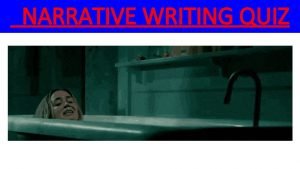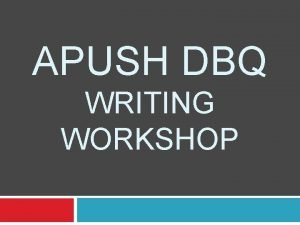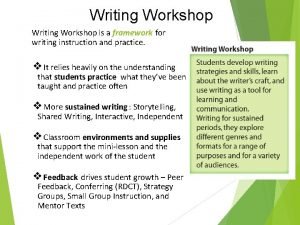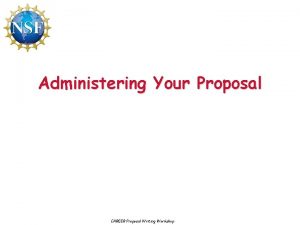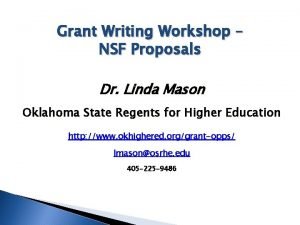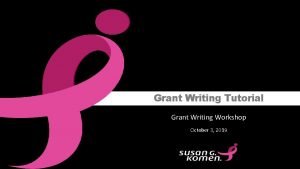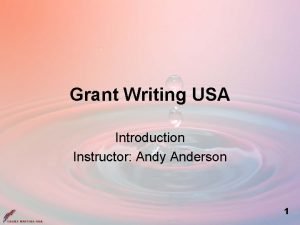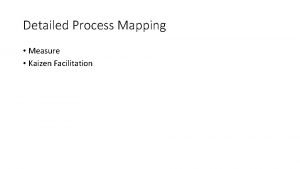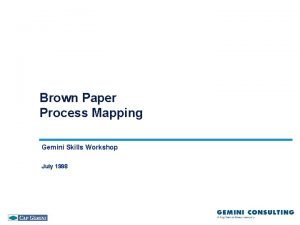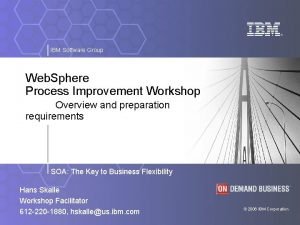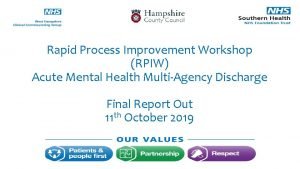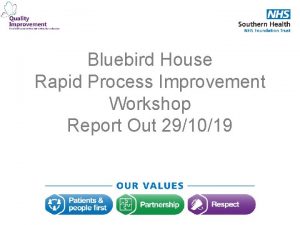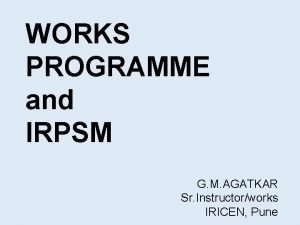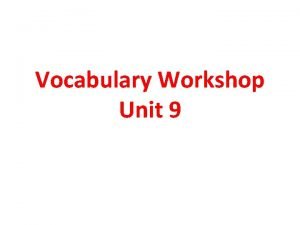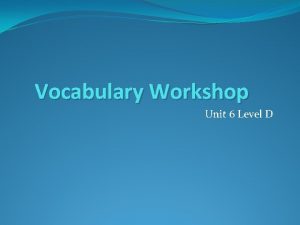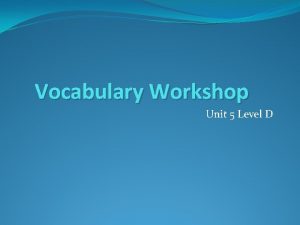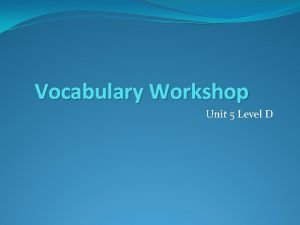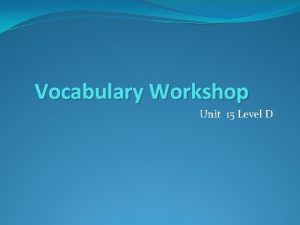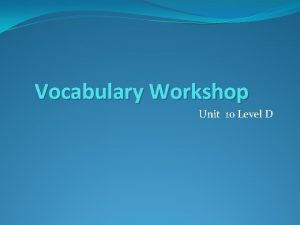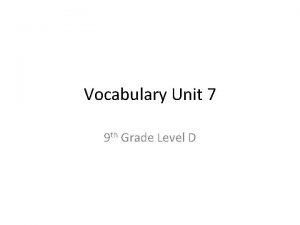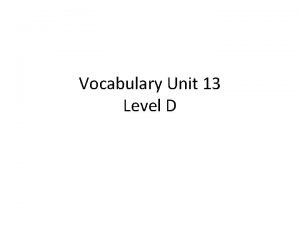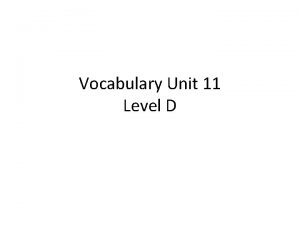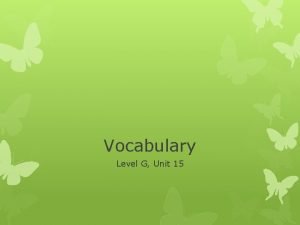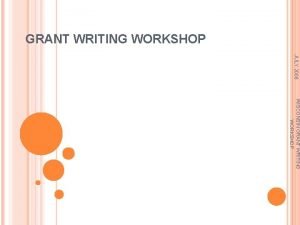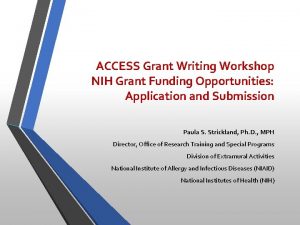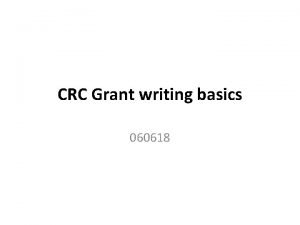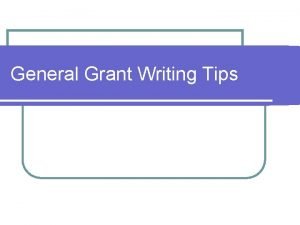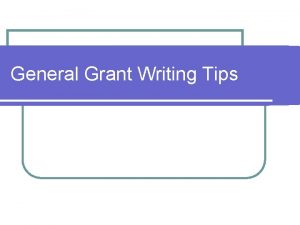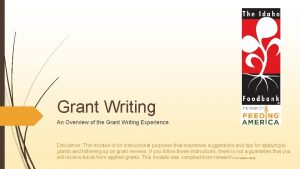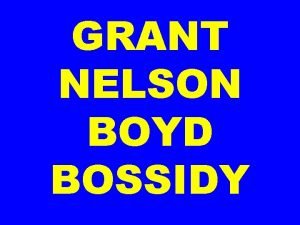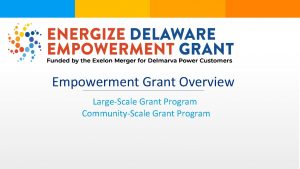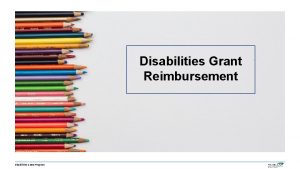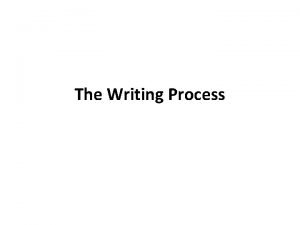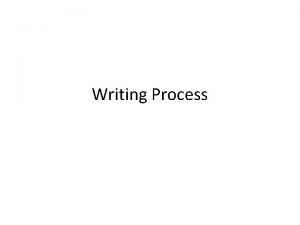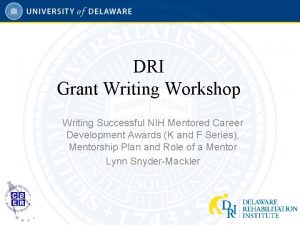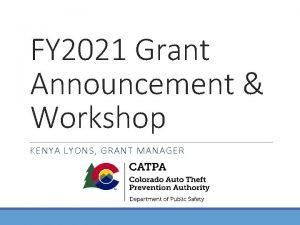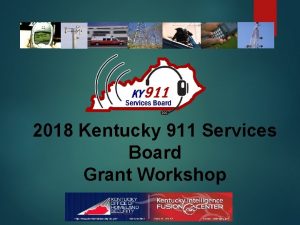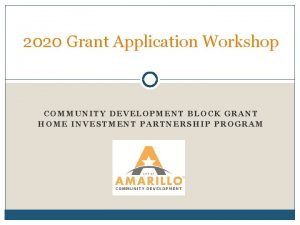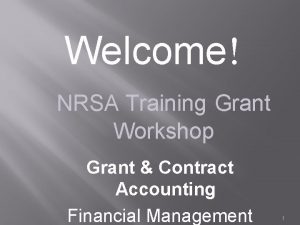Grant Writing Process Workshop The Grant Writing Process









































































- Slides: 73

Grant Writing Process Workshop

The Grant Writing Process Covers a broad scope of activities including planning and research, proposal development, and proposal follow-up. Grant writing is 80% planning and only 20% writing.

A grant is: • A giving of funds for a specific purpose • A relationship between grantor and grantee is an exchange relationship • The exchange varies with the type of grant making organization • It is not gift or charity

Two common questions that are commonly asked by grant seekers 1. “Where is the money available? ” 2. “How do I seek funding? ”

There are 2 primary sources of grant money Public Private

Examples of Public Grants Research grants: support investigation of the discovery of facts or application of new theories Demonstration grants: to demonstrate or establish the feasibility of a particular theory Project grants: support individual projects in accordance with legislation Block grants: provide states with funding for a particular purpose Formula grants: provide funding to specific grantees on the basis of a particular formula

Public Funds • Obtained from governmental units like federal, state, and local agencies. • Many of the health grant programs administered by the federal government are based on the pursuit of national objectives.

Private Funding Can be obtained from a variety of sources, such as foundations, corporations, voluntary agencies, and community groups. Private Foundations • receive income from individual, family, or groups of individuals • funding priorities are usually based on personal philosophies of the founding member o Example: § Robert Wood Johnson Foundation § W. K. Kellogg Foundation

Private Funding Corporate Foundations • receive contributions from profit-making entities • Over 2, 000 in U. S. with assets over $11 billion • Example: CIGNA, Walmart Community Foundations • are involved in grant giving within a specific community, state, or region • Example: Otto Bremer Foundation, Dakota Medical Foundation, ND Community Foundation

Seeking the Appropriate Funding Source

What is RHIhub? • Online library focused on rural health and human services. • Over 13, 000 rural relevant resources, including: o Funding opportunities o Over 60 topic guides o State pages o News o Reports and publications o Events calendar o Maps • 6 million visitors to our website • 8, 700 requests

What RHIhub Does… • Help rural communities access the full range of available programs, funding, and research • Provide easy access to information gathered from many sources https: //www. ruralhealthinfo. org/


Finding Rural Data to Support Proposals

Topic Guides Over 50 Topics On Rural Health Issues

Customized Assistance Tailored Searches of Funding Sources for Your Project Foundation Directory Search E E R F ! e c i v r Se info@ruralhealthinfo. org 1 -800 -270 -1898

Foundation Directory Online https: //fconline. foundationcenter. org/

Creating a Planning Process

Step 1 - Define your project • • • Clarify the purpose of your project and write a mission statement. Define the scope of work to focus your funding search. Determine the broad project goals, then identify the specific objectives that define how you will focus the work to accomplish those goals. Source: Corporation of Public Broadcasting - www. ncat. edu

Step 1 (cont) • • • Decide who will benefit. Draft expected project outcomes in measurable terms. Create a timeline that includes the planning phase, the period of searching for funds, proposal writing, and the intended project start date.

Step 2 - Identify the right funding sources • • Do not limit your funding search to one source. Look for a match between your project and the grants you seek by looking for consistency between the purpose and goals of your project and the funder Source: Corporation of Public Broadcasting - www. ncat. edu

Step 3 - Make direct contact with funders who support projects like yours • • • Think of the funder as a resource. Identify a project officer who will address your questions. Ask for technical assistance, including a review of proposal drafts. Some funders offer technical assistance, others do not. Source: Corporation of Public Broadcasting - www. ncat. edu

Step 4 - Acquire proposal guidelines Guidelines tell you about: • • • submission deadlines eligibility proposal format review timetable budgets funding goals and priorities Source: Corporation of Public Broadcasting - www. ncat. edu

Step 4 (cont) • • • award levels evaluation process and criteria whom to contact other submission requirements Additionally: Read the guidelines carefully, then read them again. Ask the funder to clarify your questions.

Step 5 - Know the submission deadline • • Plan to submit your proposal on or preferably before the deadline. Be realistic about whether you have time to prepare a competitive proposal that meets the deadline. Know the funder's policies on late submissions, exceptions, and mail delays. Find out how the funder will notify you about the receipt and status of your proposal. Source: Corporation of Public Broadcasting - www. ncat. edu

Step 6 - Determine personnel needs • • • Identify required personnel both by function and, if possible, by name. Contact project consultants, trainers, and other auxiliary personnel to seek availability, acquire permission to include them in the project, and negotiate compensation. Personnel compensation is important budget information. Source: Corporation of Public Broadcasting - www. ncat. edu

Step 7 - Update your timeline • Factor into your schedule time to write multiple drafts, gather relevant and permissible materials, and prepare an impartial critique of your proposal for clarity, substance, and form. Source: Corporation of Public Broadcasting - www. ncat. edu

Planning Raises Essential Questions • • • What is the problem? What do we want to do about it? How do we want to do it? Who is going to do it? How much will it cost? When/Where will it occur? How does the proposal fit our mission? Who will be involved in writing the grant? Who will be administering the grant?

WRITING & DEVELOPMENT TIPS

Writing and Development Tips • Read directions carefully o Read, and re-read • Develop an outline of each required component • Proposal should look like one person wrote it, even if done by a committee (have an editor) • One person should be responsible for coordinating proposal planning and development • Show that funding the proposal will benefit many -- social benefit

Writing and Development Tips Remember others • Talk to others who have written grants – their experience, lessons learned • Try to locate people who have been funded by organizations you plan to submit a proposal • UND Center for Rural Health, Kalisi ‘Ulu’ave, most importantly - talk to the funder! • Associations and other regional or state organizations • RHIhub

Writing and Development Tips Remember your audience: The Reviewer • Typically doesn’t know anything about your situation, your community, or even your state • Explain basic facts • Rural and frontier as a concept (distance, weather, roads); culture; and your unique circumstances • Central goal: convince reviewer of the legitimacy of your problem, your solution, your ability

Writing and Development Tips Remember Your Audience: The Reviewer • MUST MAKE IT EASY FOR THE REVIEWER • Don’t deviate from the guidance o they set the order of sections and the titles o they set the rules o they have the money • Be detailed (even to the point of being elementary) • Be concise (less words the better)

Writing and Development Tips • Remember Your Audience: Reviewer • Put yourself in the funding source’s shoes • Ask yourself same questions that a skeptical reader would ask: o Why should anyone bother to read this? o Why should they care? o What difference is this going to make? • Present it in layperson’s words -- program officer may not be an expert in your field and they have to explain the proposal to others

Writing and Development Tips Remember Your Audience: Reviewer • Show that it impacts real people • Emphasize collaborative nature of process and outcome • Show you included target audience in planning stage • Find a hook, novel way of looking at the situation and show promise • Show prospect of replication • Show plan for sustainability and continuation – essential!

Writing and Development Tips Logic • Does it make sense? • Can a reviewer easily and quickly understand your situation and your solution? • Is there a flow to the argument? Is there a flow to the solution? Is there linkage between the problem and the solution? • Avoid being “too” intuitive

Writing and Development Tips Writing Style • Develop a writing schedule -- timelines • Allow appropriate time to write and review -- takes three times longer than we usually plan • Use an outline • Use note cards

Writing and Development Tips Writing Style • Keep paragraphs short -- use headings and subheadings • Rational, documented facts -- show emotion and feeling but don’t let it dominate • Use tables, charts, graphs – be visual • Use bullets -- easy to read and follow -- shows logic • Avoid abbreviations, acronyms, and jargon if you can but if used then EXPLAIN o CRH – Center for Rural Health

Writing and Development Tips Review and critique • Allow time -- critical step • Use an external reviewer • Similar to “real” review because they know little about proposal • Look for logic gaps • UND Center for Rural Health (ask us to critique)

Writing and Development Tips What does the funder, the reviewer look for in proposal? • Does it fit their criteria? • Does it make sense? • Your credibility • Budget is appropriate to meet goals • Did you follow the rules?

Writing and Development Tips Don’t Plagiarize! Be sure to: • Review and update boilerplate language on a regular basis to ensure it is accurate, relevant and transparent. • Review, update, and cite any data, charts/graphs, or statistics you used in previous proposals to ensure they accurately reflect current information.

Writing and Development Tips Always: • Use quotation marks when you copy text verbatim from a source. • Cite the original source of the idea. • Leave enough time to review your proposal before submission to ensure you haven't pasted in a paragraph without attribution. https: //www. chronicle. com/article/Plagiarism-in-Grant-Proposals/136161

Example 1 2010 Census Summary File. United States. Prepared by the U. S. Census Bureau, 2016 1 Bennett, K. Lin, Y. H. , Yuen, M. , Leonhirth, D. , & Probst, J. (2016). Vulnerable rural counties: The changing rural landscape, 2000 -2010. South Carolina Rural Health Research Center. Available at: http: //rhr. sph. sc. eud/repo rt/(134)Vulnerable_Rural_Counti es_The_Changing_Rural_L andscape_2000 -2010. pdf. 2

Example 2 Rural Communities Rural life is frequently depicted as pastoral settings with few stresses compared to its urban counterpart (Hartley, Bird, & Depmsey, 1999; Rosenthal & Fox, 2000). In reality, farming is one of the most dangerous occupations (National Safety Council, 1998). These communities are viewed generally as cultures with social organizations where people rely heavily on one another, enjoy strong natural support among them, and are loyal to the larger community (Wenger, 1992). The strengths of rural communities include strong informal support networks, cohesiveness, established interdependence, and collaboration (Gibbens, Personal Communication May 9, 2005). Changing economies in rural areas are increasing their linkages to broader social and economic forces resulting in changing social relationships that become more impersonal. Depression and suicide is becoming an increasing problem in our rural and frontier communities. Mc. Sparron (2002) found over 42 percent of North Dakota farm operators in her study were depressed, while Linn and Husaini (1987), fifteen years earlier reported 19 percent of agricultural workers were depressed. With the continuing farm crisis, the loss of the family farm that may have been in the family for generations involves a loss of employment, home, lifestyle, and identity as well as a sense of failure increasing the risk for depression and/or suicide. Many people in rural areas experience what Rowland Lyons (1989) call the “triple jeopardy” of being rural, poor and uninsured.

Writing the Proposal Remember – It Is About the Community!

• • • Proposal Sections Cover letter Abstract Introduction Needs or Problem Statement Project description/Objectives (with Goals, Time line, and Staffing plan) Evaluation Plan Sustainability Plan Budget and budget narrative Appendices

Writing the Cover Letter • Be brief and to the point • Use the same date that you’ll send the complete grant application to the funding source. • Open with the contact person’s name and title, followed by the funding source name, address, city, state, and zip code • Greet the contact person with “Dear” plus the personal title (as in Mr. , Ms. , Mrs. ) followed by the last name.

Writing the Cover Letter • Keep the first and second paragraphs short and focused • Wrap up with a summarizing paragraph. • At the bottom of the letter, include the note “ATTACHMENTS. ”


Writing the Summaries/Abstracts The project summary/abstract should briefly describe the needs that will be addressed, the proposed services, and the client population group(s) to be served. It should not refer to other parts of the application. Source: https: //www. acf. hhs. gov

Tips for Summaries/Abstracts • Should briefly describe: o the needs that will be addressed, o the proposed services o the client population group(s) to be served • Provide demographic information of target population • Explain how project will overcome one or more community barriers. • Demonstrate feasibility of project Source: https: //www. acf. hhs. gov

Organization description Demographic information of target population Existing community barriers How project will overcome community barriers Feasibility of project Source: https: //www. acf. hhs. gov

Needs or Problem Statement • Analyze the situation using the best data you have available and cite where possible • Provides an analysis of the problem and how you plan on addressing it • Outlines strengths and weaknesses of current situation • Establish the community need, not your organization’s need. The lack of a program is not the problem.

Needs Statement Examples: Example #1: Initial statement – not approved for funding: “Many of the children we will be serving come from families with a lower income. The daycares we are partnering with serve mainly the lower income kids. By us partnering with them the kids will have access to books they wouldn’t usually be able to be in contact with. ” Source: http: //healthandwelfare. idaho. gov/

Needs Statement Examples: Attempt #2 : Was approved for funding In the 2010 -2011 school year 90% of our Kindergarten students qualified for free/reduced lunch. At the beginning of the school year 68% did not meet the benchmark for the IRI (Idaho Reading Indicator). 19% of our Preschool and Kindergarten students have developmental disabilities/delays. 23% of the Kindergarten students are English Language Learners. These children must have access to books in order to be better prepared when they enter kindergarten, and we can provide them through this program if our application is accepted. Source: http: //healthandwelfare. idaho. gov/

Writing the Project Description • SMART objectives: o o o Specific Measurable Attainable Realistic Timebound

Writing the Project Description • Should contain a clear description of the activities you plan to conduct to move toward the goals and objectives you have stated. • Go through the same steps your organization will take to develop and carry out the program or project. • The reader should easily see how you are going to accomplish your goal. • Use words, timelines, and charts, help them imagine what the program will look like. • Paint a picture of how the program will look through the eyes of a your target population. • Don’t make the funder guess how you will use the money to reach the desired result for your population.

The Evaluation • Internal or External? • Quantitative data • Qualitative data • How will the evaluation be performed? • What data will be collected? When? • How will it be analyzed and reported

The Evaluation • Check the guidance • Two common types of measures: • Process measures • Outcome measures

The Evaluation • Formative Evaluation • Summative Evaluation • It’s important that the evaluation contributes to sustainability

Example Evaluation Section of Proposal Measuring the Success of the Ridge, Kids and Stewards Program Currently, program facilitators administer both a pretest and a posttest to youth participants in order to measure what information is learned by the students during the six-week program. At the conclusion of each session, we also ask participating teachers to complete a detailed evaluation questionnaire so we can continue to find ways to improve an already excellent program. The Ridge, Kids and Stewards (RDK) program is also regularly evaluated by an outside panel of professional evaluators. Because it is our goal to teach young people to become stewards of the environment, the RKS program coordinator and others are working to develop a more sophisticated, yet practical, evaluation process in order to measure the long-term impact of the program on youth who participate. https: //www. thebalancesmb. com/grant-proposal-evaluation-section-2501961

Sustainability • Building awareness and support • Originates from accomplishment of goals and objectives • Benefit of the program to the community • Importance of evaluation to sustainability • Building relationships • Community exposure • Communication plan • Local and non-local funding sources – Private and Public: Fee-for Service

Budget A well-defined budget defines all costs related to project implementation including the funding source contribution and other contributors (inkind support, matching funds).

Matching Funds Participation by the grantee in the cost of a program on a dollar-for-dollar basis or other predetermined ratio or basis, such as 10% or 20%

Direct Costs • • Salaries and wages of personnel who will work on the project Fringe benefits associated with these personnel o Taxes (FICA, Medicare, etc. ) o Benefits (health insurance, disability insurance, retirement contributions, pension plan, etc. ) Equipment needed to perform the tasks (purchased or leased equipment) Supplies Travel (purpose of travel should be outlined) Consultant services Subcontracts

Indirect Costs Budget item that represents costs incurred by the grantee in carrying out a program that are not readily identified a direct expenditure. • Space (rent) • Utilities • % of Management Time (Executive Director oversight, accounting assistance, human resources)

Budget Table SAMPLE ONLY Example in Tab 14 $2, 500 maximum allowed on grant; $2, 011 amount being requested from the grant

Budget Narrative • How many organizations are contributing to the budget? • What percent of funds are being solicited from the funding source? • What year will peak funding occur and why? • Are subcontracts involved? • Annual salary increases

Budget Narrative SAMPLE ONLY

Other possible sections • Credibility – why should the funder invest in you and your project? They want to know that you will spend their money wisely. If this section is requested, demonstrate your ability through concrete examples: • The CFO will be managing the grant funds and has 12 years of grant management experience, 8 years with XX hospital. • XX hospital has received and managed several grants over the years, including the Flex grant administered through the Center for Rural Health for 13 years and the BCBSND Rural grant for 4 years.

Follow-up • Check notification dates • Write thank-you note, funded or not • If successfully funded, read Notice of Grant Award (NGA) carefully If proposal is not funded, ask for feedback from funding agency • • Rewrite/Resubmit • Explore other funding sources

Reasons for not receiving a grant: • Inadequate planning or carelessly prepared proposal - 39% • Competency of applicant not shown - 38% • Nature of project - 18% • Misc. - 5% Source: U. S. Public Health Service

Final Take-Away • Start a Credibility File • Start a Boiler Plate File • Make a list of 3 -5 projects you would like to do • Remember CRH and RHIhub as a resource • Read guidance carefully and develop an outline/checklist • If successfully funded - Be accountable/timely to funding agency - Communicate • If not successful - Try again!
 Narrative quiz
Narrative quiz Hát kết hợp bộ gõ cơ thể
Hát kết hợp bộ gõ cơ thể Bổ thể
Bổ thể Tỉ lệ cơ thể trẻ em
Tỉ lệ cơ thể trẻ em Gấu đi như thế nào
Gấu đi như thế nào Chụp tư thế worms-breton
Chụp tư thế worms-breton Chúa sống lại
Chúa sống lại Môn thể thao bắt đầu bằng từ chạy
Môn thể thao bắt đầu bằng từ chạy Thế nào là hệ số cao nhất
Thế nào là hệ số cao nhất Các châu lục và đại dương trên thế giới
Các châu lục và đại dương trên thế giới Công thức tính thế năng
Công thức tính thế năng Trời xanh đây là của chúng ta thể thơ
Trời xanh đây là của chúng ta thể thơ Cách giải mật thư tọa độ
Cách giải mật thư tọa độ Phép trừ bù
Phép trừ bù độ dài liên kết
độ dài liên kết Các châu lục và đại dương trên thế giới
Các châu lục và đại dương trên thế giới Thơ thất ngôn tứ tuyệt đường luật
Thơ thất ngôn tứ tuyệt đường luật Quá trình desamine hóa có thể tạo ra
Quá trình desamine hóa có thể tạo ra Một số thể thơ truyền thống
Một số thể thơ truyền thống Cái miệng nó xinh thế chỉ nói điều hay thôi
Cái miệng nó xinh thế chỉ nói điều hay thôi Vẽ hình chiếu vuông góc của vật thể sau
Vẽ hình chiếu vuông góc của vật thể sau Biện pháp chống mỏi cơ
Biện pháp chống mỏi cơ đặc điểm cơ thể của người tối cổ
đặc điểm cơ thể của người tối cổ Thứ tự các dấu thăng giáng ở hóa biểu
Thứ tự các dấu thăng giáng ở hóa biểu Vẽ hình chiếu đứng bằng cạnh của vật thể
Vẽ hình chiếu đứng bằng cạnh của vật thể Tia chieu sa te
Tia chieu sa te Thẻ vin
Thẻ vin đại từ thay thế
đại từ thay thế điện thế nghỉ
điện thế nghỉ Tư thế ngồi viết
Tư thế ngồi viết Diễn thế sinh thái là
Diễn thế sinh thái là Các loại đột biến cấu trúc nhiễm sắc thể
Các loại đột biến cấu trúc nhiễm sắc thể Số nguyên là gì
Số nguyên là gì Tư thế ngồi viết
Tư thế ngồi viết Lời thề hippocrates
Lời thề hippocrates Thiếu nhi thế giới liên hoan
Thiếu nhi thế giới liên hoan ưu thế lai là gì
ưu thế lai là gì Sự nuôi và dạy con của hổ
Sự nuôi và dạy con của hổ Khi nào hổ mẹ dạy hổ con săn mồi
Khi nào hổ mẹ dạy hổ con săn mồi Sơ đồ cơ thể người
Sơ đồ cơ thể người Từ ngữ thể hiện lòng nhân hậu
Từ ngữ thể hiện lòng nhân hậu Thế nào là mạng điện lắp đặt kiểu nổi
Thế nào là mạng điện lắp đặt kiểu nổi Chapter 13: writing workshop -- résumés
Chapter 13: writing workshop -- résumés Writing workshop a document based essay
Writing workshop a document based essay Writing workshop framework
Writing workshop framework Business plan writing workshop
Business plan writing workshop Proposal writing on career guidance workshop
Proposal writing on career guidance workshop Career guidance presentation
Career guidance presentation Proposal writing on career guidance workshop
Proposal writing on career guidance workshop Grant writing examples
Grant writing examples Grant writing tutorial
Grant writing tutorial Grant writing usa
Grant writing usa Process mapping workshop facilitation
Process mapping workshop facilitation Brown paper workshop
Brown paper workshop Ibm checkpoint goals examples
Ibm checkpoint goals examples Rpiw process
Rpiw process Rapid process improvement workshop
Rapid process improvement workshop Workshop visual thinking
Workshop visual thinking Cutting tools example
Cutting tools example Workshop pop art
Workshop pop art Amazon alexa workshop
Amazon alexa workshop Workshop goals examples
Workshop goals examples Irpsm
Irpsm Unit 9 vocabulary workshop
Unit 9 vocabulary workshop Unit 6 level b synonyms
Unit 6 level b synonyms Vocabulary workshop unit 5
Vocabulary workshop unit 5 Unit 5 level d synonyms and antonyms
Unit 5 level d synonyms and antonyms Unit 15 vocabulary workshop level d
Unit 15 vocabulary workshop level d Vocabulary workshop level d unit 10
Vocabulary workshop level d unit 10 Vocabulary level d unit 7
Vocabulary level d unit 7 Unit 13 level d
Unit 13 level d Vocab unit 11 level f
Vocab unit 11 level f Sadlier vocabulary workshop level g unit 15
Sadlier vocabulary workshop level g unit 15
